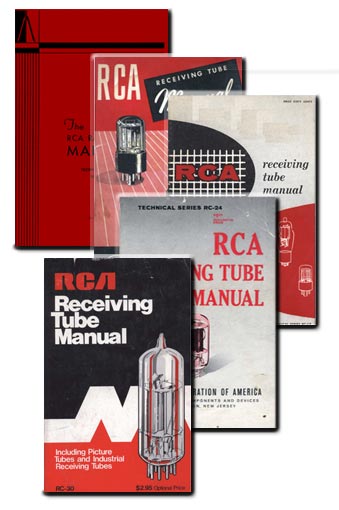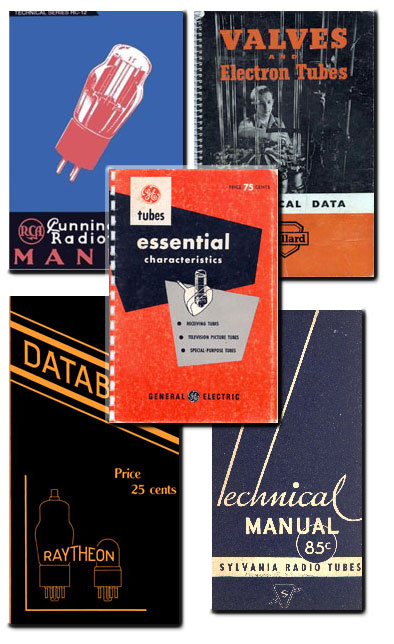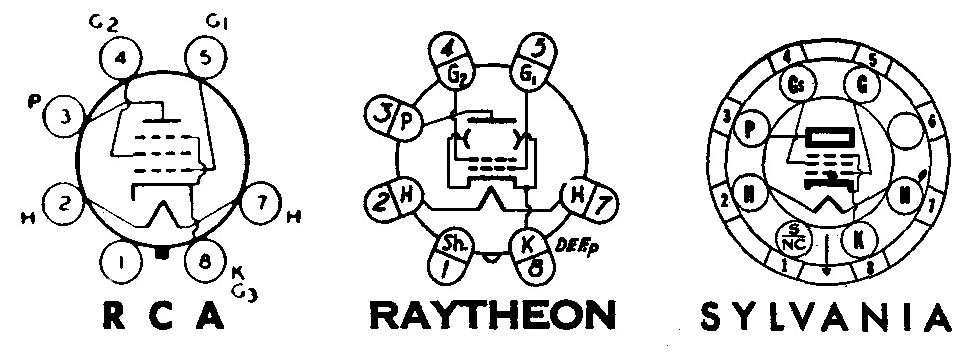The major tube manufacturers published technical manuals describing the characteristics of their various products. For the purposes of this discussion, I've concentrated on "receiving" tube manuals only, as these are the tubes that are found in radios and audio amplifiers.
Receiving tube manuals are generally the largest anyway, and describe the most tubes. Most included cathode-ray tubes (i.e. television picture tubes), magic eye tubes, and others that were commonly found in radio, television or audio equipment of the time. Transmitting tubes usually got a separate manual.
It's easy to think that all you need is just one tube manual, preferably the latest and greatest, and you're good to go. However, different manufacturer's manuals, even different editions from the same manufacturer, had their relative strengths and weaknesses. So I'm going to discuss a variety of manuals and suggest which may be the best choices for various needs.
RCA Receiving Tube Manuals
 RCA was the industry leader in the United States, and they offered the most and, in my opinion, the best tube manuals available.
RCA was the industry leader in the United States, and they offered the most and, in my opinion, the best tube manuals available.
The earliest edition I've seen is called RC-10, from 1932 (there may be earlier editions but I haven't found any). The last edition was RC-30 from 1975, which is still sold "new" as reprints.
There is also a huge tube encyclopedia that RCA made called the HB3. Print editions are expensive but there are PDF copies available on the internet.
To explain the value of the HB3 you have to understand something about how the regular books are set up. Because of the monsterous number of tube types that had been made over the 60-some years that tubes were being designed and manufactured, the regular manuals could not offer full data on each and every one. What they did was condense the old and obsolete types and present the data as a summary in a table, because in many cases that was enough. Someone working on radios in 1970 rarely needed detailed data on an old 24A —if they needed anything, it was just the filament voltage and current, the base pin-out, and the plate voltage. Summarizing data like that kept the later manuals down to a usable size.
Someone specializing in pre-World War II radios, however, might want the full data on a 24A. In that case, he either needed to consult an earlier RCA manual that would have the data, or he could just go to the HB-3.
The HB-3 was an encyclopedia, but one doesn't always want an encyclopedia when a quick pocket reference will do. So the regular manuals are still valuable and useful to own.
But even the regular editions suffer from bloat, particularly toward the end of the run. The tube manuals went through two major explosions in tube types: first in the 1950s as television phased in, and then again in the 1960s as color television took over. For a good comparision, look at the 1947 edition, the 1959 edition, the 1965, and 1975 editions. 1947's is 260 pages; 1959 is 436 pages; 1965 went to 580 and 1975 went to 762 (page counts all come from my PDF copies). All RCA manuals included non-tube data, such as sections on how tubes worked, sample applications, and the like, but the "filler" didn't swell over the years; most of the excess bulk came from tube data.
The question is which one(s) to get. A lot of it depends on the era you most often find yourself working on, because you want the full data for tubes you're most likely to see, but not data from tubes you don't care about. For people working on All-American-Five table radios, I'd look at one of the editions from the late 1950s. For people anyone working on depression-era radios, I'd consider the 1942 or 1947 edition. For 1920s era TRFs, Neutrodynes and early Superhets, the 1932 edition is indespensible.
Other Receiving Tube Manuals
RCA was the industry leader but they weren't the only game in town. Sylvania was one of its primary competitors, as were Ken-Rad, Tung Sol, Raytheon, Mullard, and others. Nobody of which I'm aware made manuals as large or as often as RCA, but they are useful in their own right.
For an example I'll pick one that I have myself, the 1951 Sylvania manual. RCA's early manuals were pamphlets; the later ones were paperback books. Sylvania's is a loose-leaf binder so that pages could be inserted, deleted or replaced to keep it up to date. Unlike the paperback book style, the Sylvania book opens and lies flat on the tabletop; the leatherette cover lets it take some knocking-about in a tube caddy where a paperback book or pamphlet tends to do better on a shelf.
Beyond that, there are two important differences. One is that the Sylvania book (and I presume the others do as well) includes tube types that RCA did not manufacture. My Sylvania edition includes the infamous 1L6, which only briefly appears in RCA's literature (though it is in the HB3).
The other major difference is in how the information is presented, such as the basing configuration. Here are three different manufacturer's base diagrams for the same 6V6 tube.
They all show the same thing but in a different way. I haven't seen Raytheon's version anywhere outside their own reference manual, but both RCA and Sylvania's diagrams are used in schematic drawings of radio or amplifiers that I've seen; which one is used depends on which brand manufacturer preferred. RCA is the most common, but my 1948 Wards Airline 84WG table radio uses the Sylvania method.
a la Carte Data Sheets
 Just about any tube's data sheet can be found on the internet using Google or other search engines. My experience with this is that I often end up with pages from manufacturers I don't normally see in print: General Electric comes up a lot (I don't have a GE manual in any form); so do a lot of the european manufacturers like Philips and Mullard. Popular tubes that were still being manufactured in the 1990s like the 12AX7 may bring up datasheets from former Soviet-bloc countries. It is amazing what's available.
Just about any tube's data sheet can be found on the internet using Google or other search engines. My experience with this is that I often end up with pages from manufacturers I don't normally see in print: General Electric comes up a lot (I don't have a GE manual in any form); so do a lot of the european manufacturers like Philips and Mullard. Popular tubes that were still being manufactured in the 1990s like the 12AX7 may bring up datasheets from former Soviet-bloc countries. It is amazing what's available.
Sources
Most of the manuals can be purchased as used print-editions from any number of retailers. Your best bet is to check eBay, Etsy, Amazon, or your favorite used-book sellers. When shopping on eBay, Amazon, and other such sites, be sure to compare carefully because prices vary wildly from one seller to the next. Some people think the manuals are worth their weight in platinum; others almost give them away.
A few sellers offer reprints of RCA's last edition, RC-30. That's a good way to get a tight, clean, "new" copy. Again, check pricing.
Many tube manuals can be downloaded in PDF format for free; it's a great way to get a number of tube manuals for your virtual reference shelf. See my Links page for sources.
My own personal preference is to have as many different manuals in PDF format as I can get, plus a couple print editions for use in the shop. I usually don't have a computer on my workbench, and I find it's a lot easier to grab a book off a nearby shelf, than to have to go to my computer and search through PDF documents. At the moment I've got a print edition of RCA's 1959 manual and one of the Sylvanias from the early 50s. Between the two I can find almost anything I need.


